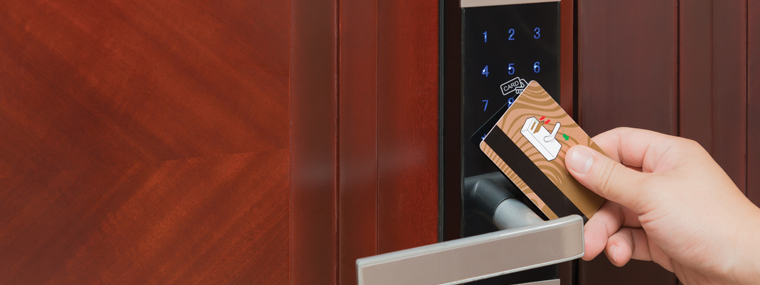
Frequently Asked Questions: Access Control
What Types of Access Control Exist?
By Brie Peterson / Published November 2017
One of the most common security measures used in communities and businesses is access control. This type of system uses database technology paired with an individual identifier to grant or deny access through gates or doors. In addition to controlling who is permitted to enter an area or room, the system can allow officials to set authorized times for access. While it is a common basic solution, there are a variety of functions and types that exist to assist communities with specific areas.
For standard doors or gates that give access to a clubhouse, pool, or other community amenities, a key card or fob is typically issued as a credential. When used and administered correctly, each card or fob will have a unique identifier for property officials to grant or deny access to each specific user by area and/or time. If a user—for example, a community resident—moves away, the specific identifier in the credential can be deactivated without impacting any other cards or fobs.
While the installation of card or fob readers is fairly easy and affordable, there are some security risks involved with these identifiers. For instance, the card or fob may be passed to a non-resident or a person who is not supposed to have access to an area. Cards and fobs are also easily lost. If the lost card is not reported, then it cannot be deactivated unless the resident moves out. In some instances, it is also possible to duplicate a credential.
Key cards and fobs can also be used to grant access through a gated community entrance in a resident lane. However, vehicle stickers are often a simpler choice for residents who use the gate frequently. Just like a card or fob, a vehicle sticker has an identifier unique to each user that is recognized by a nearby RFID reader when the driver pulls up. Sometimes the vehicle sticker is placed on the windshield (similar to a SunPass), and other times a sticker can be used on a vehicle headlamp. This is especially important for vehicles with metallic film in the windshield, which can interfere with the radio frequency waves. Vehicle stickers are less of a security risk as they are much harder to duplicate and each sticker breaks upon removal.
If there is a fear that credentials may be lost or that they are not cost effective for a community, there is the option of key pad codes. With this method, each user can have an individual code, or a shared code can be given to permitted users. However, whether an individual or shared code is used, it is probable that the code will be told to non-residents or unapproved users.
Another method of access control is the use of biometric identifiers, such as facial recognition or fingerprints. This method is not effective for all communities, but it does have many advantages where it is used. For instance, biometric identifiers cannot be duplicated. Therefore, the community does not have to worry about other residents sharing credentials. It can also be cost effective for very large or very small communities when the purchase of credentials is not. When considering biometric identifiers, it is important to have the most up-to-date technology installed. Older versions are often less reliable and more susceptible to malfunctioning.
When the appropriate method of access control is installed, a community should consider who will manage the database. In some cases, a property manager will control the authorization of users, and in other cases the database is managed by a security provider. When a security provider or central station manages the database, each user’s unique identifier and information is protected and secure. If other security services are also used by the same provider, the database information can be consolidated. This still gives property officials access to detailed reports of who is entering a controlled area and when, without the responsibility of maintaining the database.
Today, access control systems are flexible for the different needs and designs of communities. With a multitude of solutions, almost any area of a community can be secured for permitted users. With additional management options, the database for each community can be consolidated and continuously updated with the most accurate information to keep a community and its amenities safe.
If you have security questions or concerns, please email ask@envera systems.com.
Brie Peterson
Business Development Consultant for Envera Systems
Brie Peterson is the Sr. Business Development Consultant for Envera Systems. She works closely with the sales and marketing departments to provide best-in-class service to the communities that Envera works with. Envera Systems specializes in security technology systems with remote guards to replace or enhance guards at communities. Contact info: (855) 380-1274 or www.EnveraSystems.com.



